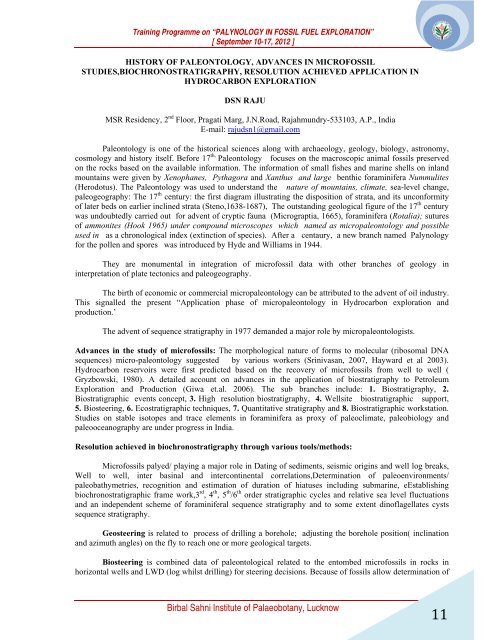SOUVENIR COMMITTEE - Birbal Sahni Institute of Palaeobotany
SOUVENIR COMMITTEE - Birbal Sahni Institute of Palaeobotany
SOUVENIR COMMITTEE - Birbal Sahni Institute of Palaeobotany
You also want an ePaper? Increase the reach of your titles
YUMPU automatically turns print PDFs into web optimized ePapers that Google loves.
Training Programme on “PALYNOLOGY IN FOSSIL FUEL EXPLORATION”<br />
[ September 10-17, 2012 ]<br />
HISTORY OF PALEONTOLOGY, ADVANCES IN MICROFOSSIL<br />
STUDIES,BIOCHRONOSTRATIGRAPHY, RESOLUTION ACHIEVED APPLICATION IN<br />
HYDROCARBON EXPLORATION<br />
DSN RAJU<br />
MSR Residency, 2 nd Floor, Pragati Marg, J.N.Road, Rajahmundry-533103, A.P., India<br />
E-mail: rajudsn1@gmail.com<br />
Paleontology is one <strong>of</strong> the historical sciences along with archaeology, geology, biology, astronomy,<br />
cosmology and history itself. Before 17 th, Paleontology focuses on the macroscopic animal fossils preserved<br />
on the rocks based on the available information. The information <strong>of</strong> small fishes and marine shells on inland<br />
mountains were given by Xenophanes, Pythagora and Xanthus and large benthic foraminifera Nummulites<br />
(Herodotus). The Paleontology was used to understand the nature <strong>of</strong> mountains, climate, sea-level change,<br />
paleogeography: The 17 th century: the first diagram illustrating the disposition <strong>of</strong> strata, and its unconformity<br />
<strong>of</strong> later beds on earlier inclined strata (Steno,1638-1687), The outstanding geological figure <strong>of</strong> the 17 th century<br />
was undoubtedly carried out for advent <strong>of</strong> cryptic fauna (Micrograptia, 1665), foraminifera (Rotalia); sutures<br />
<strong>of</strong> ammonites (Hook 1965) under compound microscopes which named as micropaleontology and possible<br />
used in as a chronological index (extinction <strong>of</strong> species). After a centaury, a new branch named Palynology<br />
for the pollen and spores was introduced by Hyde and Williams in 1944.<br />
They are monumental in integration <strong>of</strong> micr<strong>of</strong>ossil data with other branches <strong>of</strong> geology in<br />
interpretation <strong>of</strong> plate tectonics and paleogeography.<br />
The birth <strong>of</strong> economic or commercial micropaleontology can be attributed to the advent <strong>of</strong> oil industry.<br />
This signalled the present “Application phase <strong>of</strong> micropaleontology in Hydrocarbon exploration and<br />
production.’<br />
The advent <strong>of</strong> sequence stratigraphy in 1977 demanded a major role by micropaleontologists.<br />
Advances in the study <strong>of</strong> micr<strong>of</strong>ossils: The morphological nature <strong>of</strong> forms to molecular (ribosomal DNA<br />
sequences) micro-paleontology suggested by various workers (Srinivasan, 2007, Hayward et al 2003).<br />
Hydrocarbon reservoirs were first predicted based on the recovery <strong>of</strong> micr<strong>of</strong>ossils from well to well (<br />
Gryzbowski, 1980). A detailed account on advances in the application <strong>of</strong> biostratigraphy to Petroleum<br />
Exploration and Production (Giwa et.al. 2006). The sub branches include: 1. Biostratigraphy, 2.<br />
Biostratigraphic events concept, 3. High resolution biostratigraphy, 4. Wellsite biostratigraphic support,<br />
5. Biosteering, 6. Ecostratigraphic techniques, 7. Quantitative stratigraphy and 8. Biostratigraphic workstation.<br />
Studies on stable isotopes and trace elements in foraminifera as proxy <strong>of</strong> paleoclimate, paleobiology and<br />
paleooceanography are under progress in India.<br />
Resolution achieved in biochronostratigraphy through various tools/methods:<br />
Micr<strong>of</strong>ossils palyed/ playing a major role in Dating <strong>of</strong> sediments, seismic origins and well log breaks,<br />
Well to well, inter basinal and intercontinental correlations,Determination <strong>of</strong> paleoenvironments/<br />
paleobathymetries, recognition and estimation <strong>of</strong> duration <strong>of</strong> hiatuses including submarine, eEstablishing<br />
biochronostratigraphic frame work,3 rd , 4 th , 5 th /6 th order stratigraphic cycles and relative sea level fluctuations<br />
and an independent scheme <strong>of</strong> foraminiferal sequence stratigraphy and to some extent din<strong>of</strong>lagellates cysts<br />
sequence stratigraphy.<br />
Geosteering is related to process <strong>of</strong> drilling a borehole; adjusting the borehole position( inclination<br />
and azimuth angles) on the fly to reach one or more geological targets.<br />
Biosteering is combined data <strong>of</strong> paleontological related to the entombed micr<strong>of</strong>ossils in rocks in<br />
horizontal wells and LWD (log whilst drilling) for steering decisions. Because <strong>of</strong> fossils allow determination <strong>of</strong><br />
<strong>Birbal</strong> <strong>Sahni</strong> <strong>Institute</strong> <strong>of</strong> <strong>Palaeobotany</strong>, Lucknow<br />
11

















